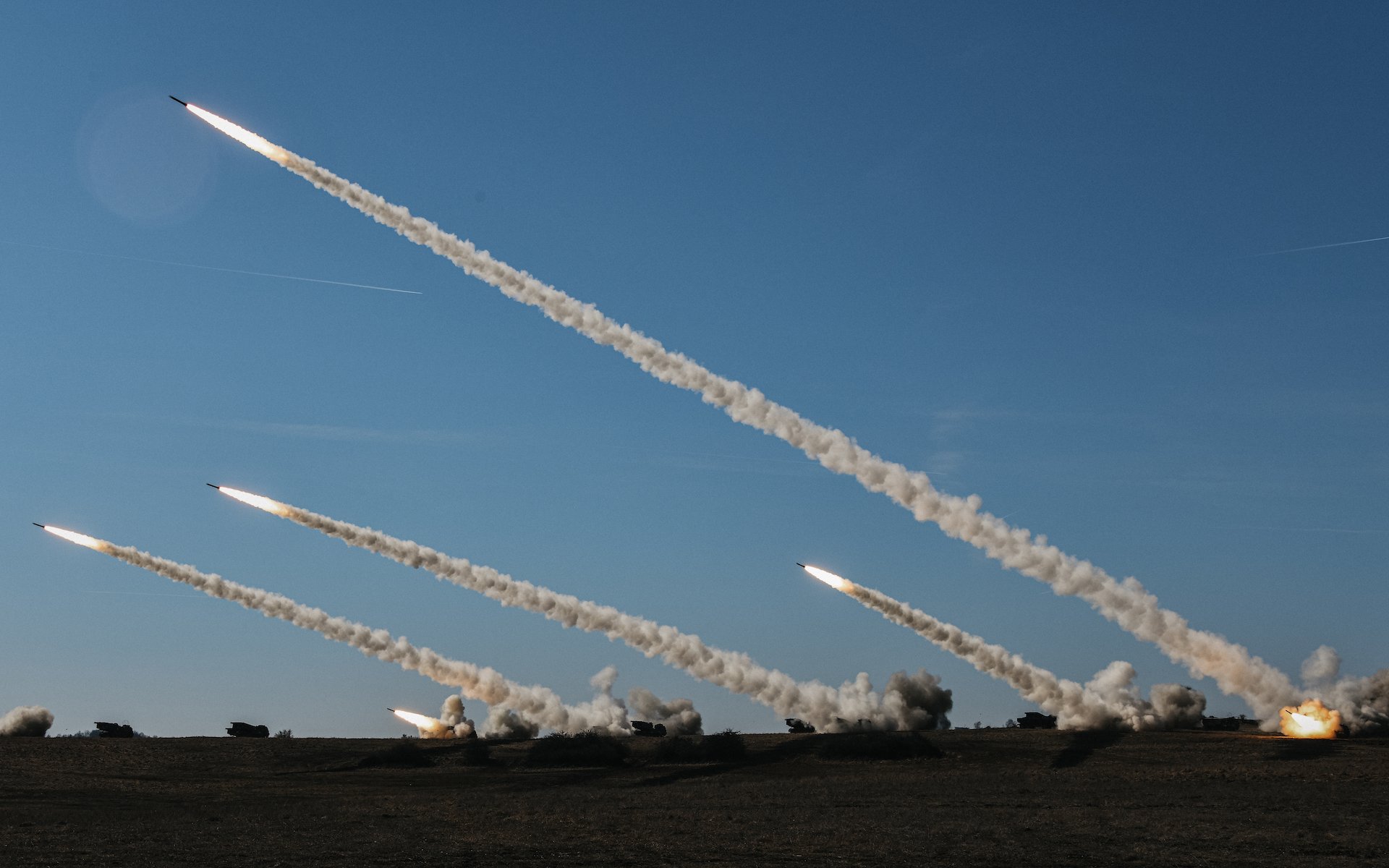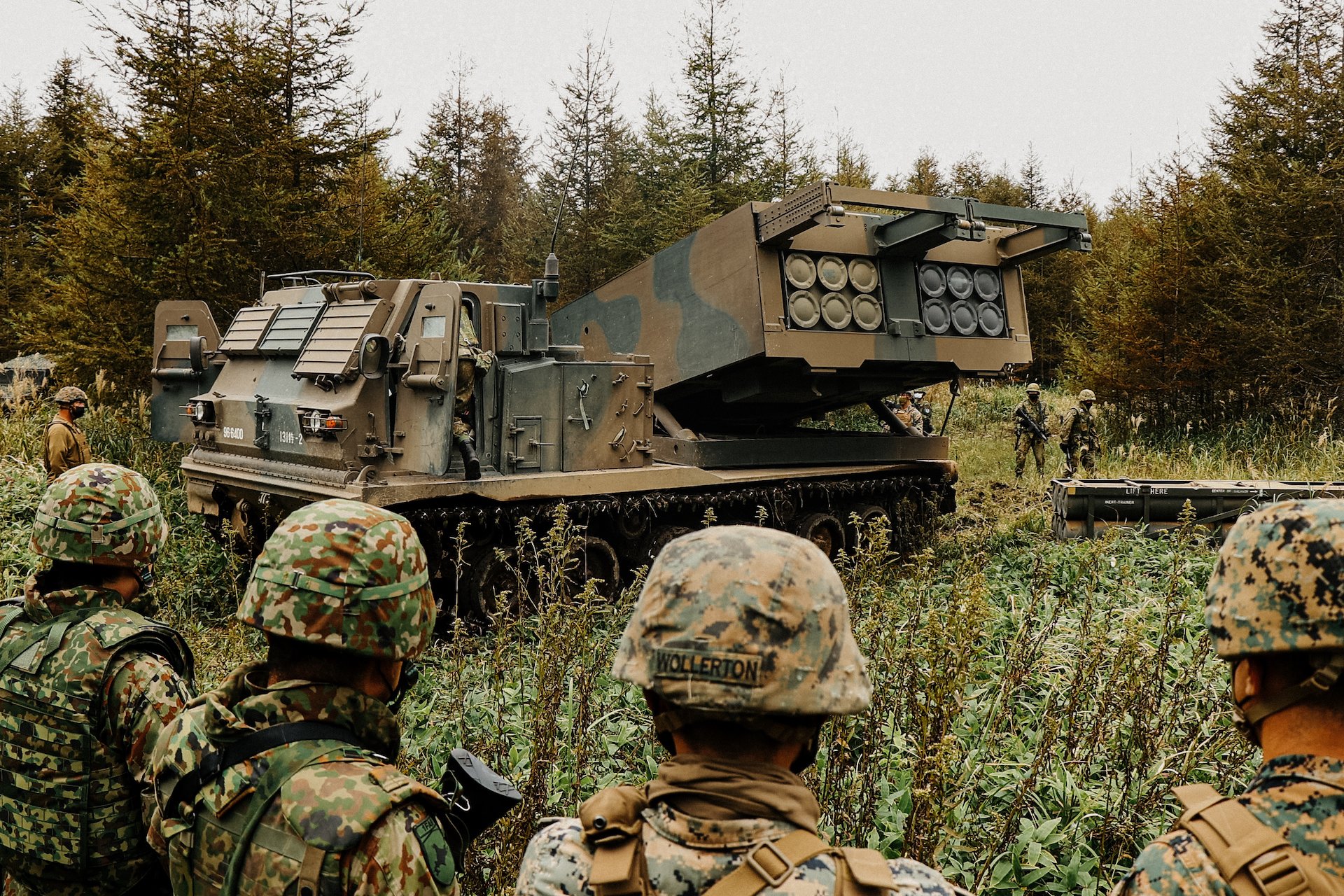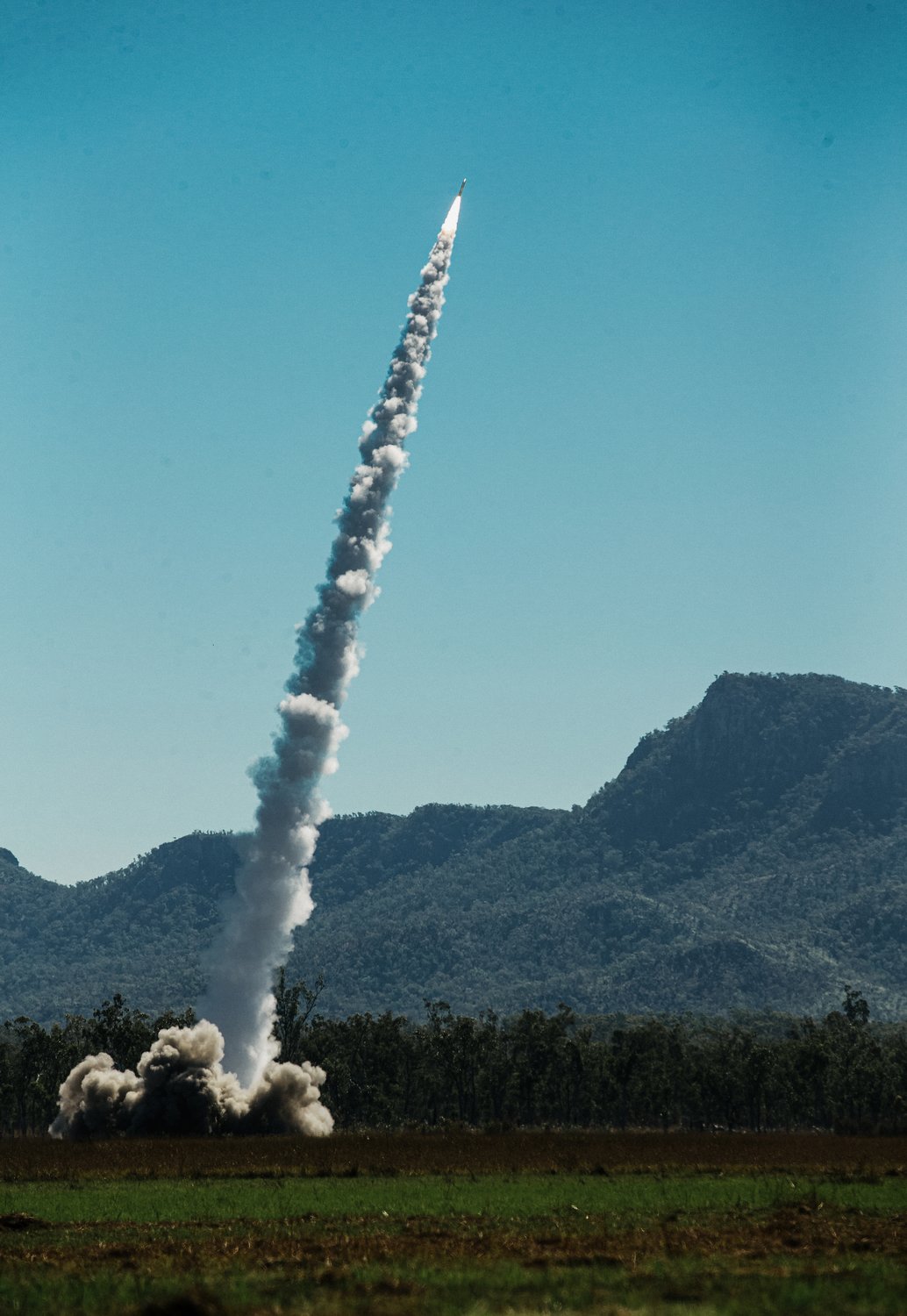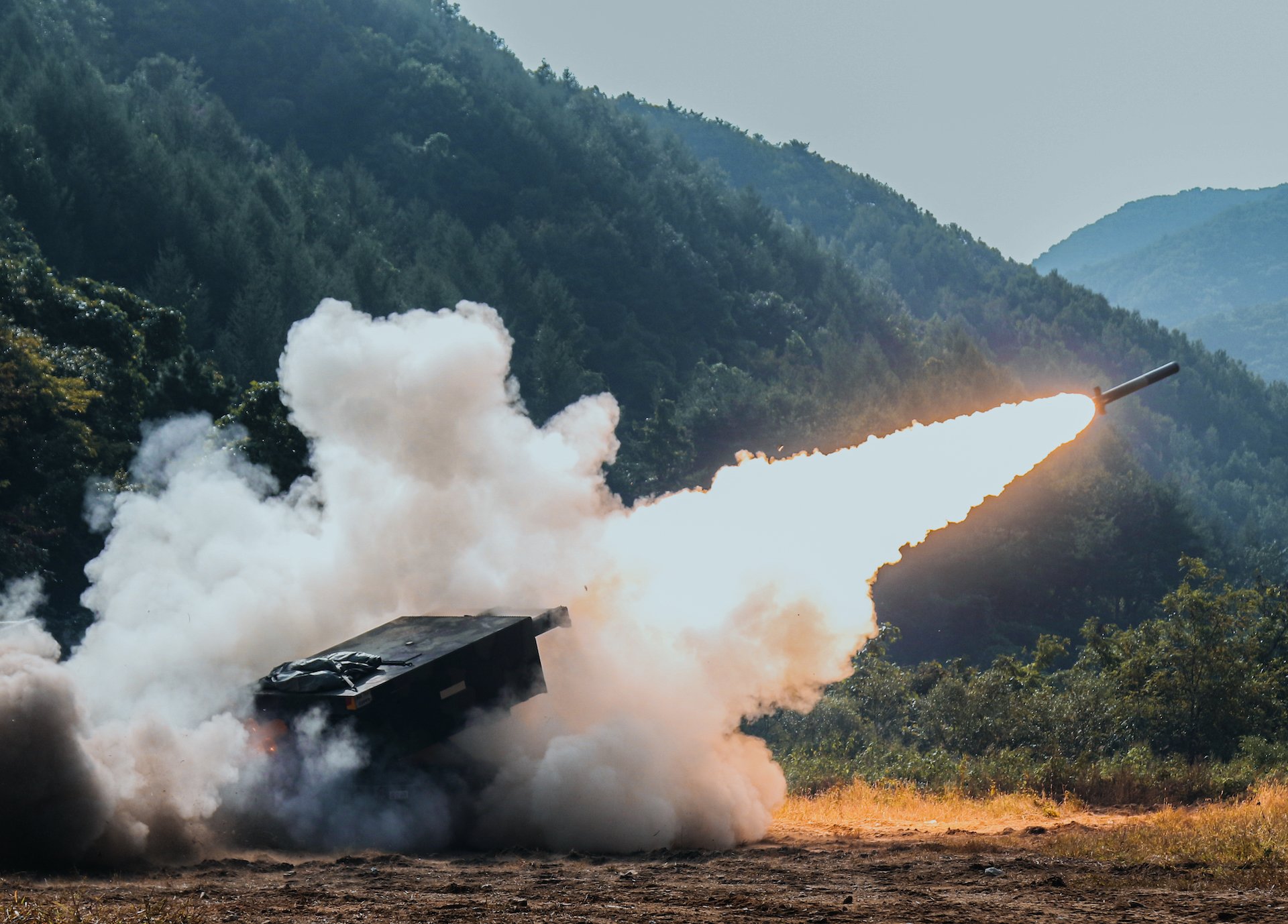
Soldiers assigned to the 41st Field Artillery Brigade fire M270 Multiple Launch Rocket Systems during a live fire exercise at the 7th Army Training Command’s Grafenwoehr Training Area, Germany, March 11, 2022. US Army photo by Markus Rauchenberger.
In July 2022, as the war in Ukraine ground into its fifth month, the United Kingdom delivered three M270 Multiple Launch Rocket Systems to Kyiv with the promise of sending more. That same year, Germany also sent its MLRS variant, the MARS II, to the embattled country. By April 2023, Ukraine had acquired at least 10 of the weapon platforms from foreign allies.
Ukraine’s MLRS arsenal has been instrumental in holding the line against Russia. The mobile long-range rocket launchers have made it difficult for the Russian military to maneuver and fight in mass formations and have also brought its rear-echelon units, command nodes, and supply depots into striking distance. So what exactly is the MLRS? And what makes it such an effective weapon against large conventional armies?

Marines with the 12th Marine Regiment, 3d Marine Division, observe members of the Northern Army, Japan Ground Self-Defense Force, operate an M270 Multiple Launch Rocket System during a bilateral demonstration at Yausubetsu Maneuver Area, Hokkaido, Japan, Oct. 3, 2022. US Marine Corps photo by Sgt. Abrey Liggins.
MLRS 101
The Multiple Launch Rocket System was developed by the US defense technology company Vought in the mid-1970s at the height of America’s Cold War arms race with the Soviet Union. Its intended purpose was to be a weapon for destroying enemy air defenses and free up more precise cannon artillery to provide fire support for ground troops.
Nearly 50 years later, the MLRS is still a key feature of the American arsenal. The system’s longevity owes much to its formidable combination of mobility, automation, and lethality. Picture a dozen rockets atop something that looks like a tank with three soldiers in the cab awaiting orders to strike. Once a target is identified, its location is transmitted to the MLRS’s onboard computer. Then the three-man crew arms and fires the weapon, unleashing a barrage of rockets to saturate their target. The whole process takes less than a minute and is executed all from inside the vehicle.
That’s one way to describe it. To put it more technically, the M270 MLRS is a family of highly automated self-propelled loader/launchers built on the elongated chassis of a 27-ton Bradley Fighting Vehicle. A sophisticated computer, known as the fire control system, integrates the weapon with the vehicle. That computer, which is housed in the firing module, also helps calibrate the trajectory of the rockets so they can accurately strike targets hundreds of miles away.

Marines with 3d Battalion, 12th Marine Regiment, 3d Marine Division, launch a missile from an M270 MLRS during Talisman Sabre 2021 at Shoalwater Bay Training Area, Queensland, Australia, July 19, 2021. US Marine Corps photo by Lance Cpl. Alyssa Chuluda.
The M270’s ability to reach far behind enemy lines is what makes it so instrumental in Ukraine, where Russia’s massive military has pushed westward into the former Soviet state. That ability is also why Western countries initially hesitated to send Kyiv the weapon system. With the right ammo, the MLRS could strike targets well inside Russia’s borders, which would drastically escalate the conflict.
Related: The US Is Sending the NASAMS to Ukraine — but What Is It?
MLRS Family of Munitions
The M270’s effective range varies depending on the type of ordnance it’s launching. The standard loadout is a dozen Guided Multiple Launch Rocket Systems, or GMLRSs, split evenly between the M270’s pair of six-pack rocket pods. The GMLRS’s GPS-guided warhead delivers a 200-pound payload within a few feet of the designated target and from a distance of up to roughly 40 miles.
GMLRS replaced the original MLRS rocket in the 2000s. The original warhead contained 644 M77 bomblets, so that one launcher could deliver nearly 8,000 cluster munitions on target in less than 60 seconds. But since the M77 had a dud rate of 2%, using them entailed the risk of leaving hundreds of unexploded bomblets on the battlefield for friendly forces and civilians to deal with later. Hence, the U.S. Army’s decision to upgrade to the GMLRS.

A Ukrainian MLRS weapons system takes a position on the frontline at an undisclosed location in the Donetsk region, Ukraine, Thursday, Nov. 24, 2022. AP photo by Roman Chop.
Other munitions used by MLRS increase range but at the cost of fewer rounds. For example, instead of 12 GMLRSs, the M270 can be loaded with two Army Tactical Missile Systems. The ATACMS has an effective range of nearly 200 miles — approximately four times greater than the GMLRS. The latest-gen MLRS, which was first fielded in 2022, is unique from its predecessor in that it will be capable of launching up to four Precision Strike Missiles. The PrSM, which is still in development, will have a maximum effective range of about 300 miles.
Related: The M203 Grenade Launcher: Farewell to Infantry’s ‘Little Friend’
A Brief History of the MLRS
At the height of the Cold War, the Soviet Union outgunned its Western adversaries in terms of sheer rocket power. While the US preferred precision artillery systems, such as the Howitzer, the USSR favored truck-mounted launchers that could blanket targets with thousands of unsophisticated rockets to inflict maximum physical and psychological damage.
It wasn’t until the 1973 Yom Kippur War that Western militaries started to realize that there were certain strategic advantages to Moscow’s scorched-earth artillery tactics. The Arab-Israeli conflict showed that rear-echelon, long-range weapons, like surface-to-air missiles, could be hugely devastating, and, furthermore, that the best tool for countering them was a multiple-rocket-launcher system. So, in 1975, the US Army called on the private defense industry to develop mobile rocket artillery similar to Russia’s. That effort, carried out in partnership with Western Germany, France, and the UK, ultimately yielded the M270 MLRS.

Soldiers assigned to the 41st Field Artillery Brigade perform checks on an M270 MLRS as part of the Brigade Best by Test competition in the 7th Army Training Command’s Grafenwoehr Training Area, May 19, 2022. US Army photo by Cpl. Austin Riel.
The first American-made M270 MLRS unit deployed to Western Germany in 1983. Since then, the weapon system has been incorporated into the arsenals of many NATO countries, as well as the arsenals of Egypt, Japan, Saudi Arabia, Bahrain, Israel, and South Korea.
The MLRS made its big battlefield debut in the First Gulf War. While deployed along the Kuwait-Iraq border in 1991, the weapon system earned the nickname “grid killer” because of its ability to neutralize a one-square-kilometer area (represented by a grid square on a map).
Soon after the war ended, the Army got to work developing the prototype for what would become the High Mobility Artillery Rocket System, or HIMARS, a lighter, cheaper alternative to the MLRS that carries fewer rounds. Production of the M270 stopped in 2003, around the same time the first HIMARS started rolling off the assembly line.

An M270 MLRS fires during a training exercise at Rocket Valley, South Korea, Sep. 25, 2017. US Army photo by Sgt. Michelle U. Blesam.
How Many M270 MLRS Does the U.S. Have?
The advent of the HIMARS made the American military less reliant on the MLRS, but it did not render the weapon system obsolete. In fact, since the early 2000s, the M270 has undergone two major upgrades: first to the M270A1 in 2005 and then to the M270A2.
Lockheed Martin delivered the first M270A2 to the Army in the summer of 2022. The latest-gen model comes with a top-of-the-line 600 horsepower engine, a beefed-up cab with better armor to protect against mines, and an upgraded fire control system, which will also be used by HIMARS. The new control system will enable MLRS (as well as HIMARS) to fire the PrSM, as well as an extended-range GMLRS, which is also still in development.
As of 2023, Lockheed Martin is still working through the upgrades for 50 M270 launchers. The upgraded launchers are part of a bigger effort by the Army to modernize 225 M270A1s as well as 160 of the even older, decommissioned M270A0s by the end of the decade. The overhaul will extend the MLRS’s service life by decades and put the Army’s M270A2 count at 385.
Read Next: Old Ironsides: How a Poem Saved America’s Favorite Warship

Jenna Biter is a staff writer at Coffee or Die Magazine. She has a master’s degree in national security and is a Russian language student. When she’s not writing, Jenna can be found reading classics, running, or learning new things, like the constellations in the night sky. Her husband is on active duty in the US military. Know a good story about national security or the military? Email Jenna.
BRCC and Bad Moon Print Press team up for an exclusive, limited-edition T-shirt design!
BRCC partners with Team Room Design for an exclusive T-shirt release!
Thirty Seconds Out has partnered with BRCC for an exclusive shirt design invoking the God of Winter.
Lucas O'Hara of Grizzly Forge has teamed up with BRCC for a badass, exclusive Shirt Club T-shirt design featuring his most popular knife and tiomahawk.
Coffee or Die sits down with one of the graphic designers behind Black Rifle Coffee's signature look and vibe.
Biden will award the Medal of Honor to a Vietnam War Army helicopter pilot who risked his life to save a reconnaissance team from almost certain death.
Ever wonder how much Jack Mandaville would f*ck sh*t up if he went back in time? The American Revolution didn't even see him coming.
A nearly 200-year-old West Point time capsule that at first appeared to yield little more than dust contains hidden treasure, the US Military Academy said.












